Hi there! My name is Lisa Duerre. This is my story.
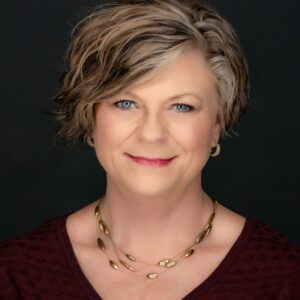 As the CEO and Co-Founder of RLD Group, a Leadership Development Coaching and Consulting Firm, I've had the privilege of helping tech companies transform their culture, eliminate burnout, and drive bottom-line results through Strengths-Based Leadership Development Solutions. It's been an incredible adventure so far.
As the CEO and Co-Founder of RLD Group, a Leadership Development Coaching and Consulting Firm, I've had the privilege of helping tech companies transform their culture, eliminate burnout, and drive bottom-line results through Strengths-Based Leadership Development Solutions. It's been an incredible adventure so far.
RLD Group, a WBENC-certified Woman-Owned Leadership Consulting Firm, specializes in HR strategy, organizational design, leadership pipelines, talent retention, burnout prevention, and team performance in the complex hybrid-work world. We aim to put the heart of the human back into the tech industry and create the firm leaders of tomorrow.
Before launching RLD Group, I spent over 20 years as a rising executive within Fortune 500 tech companies in Silicon Valley. Drawing upon my corporate experience and my love for facilitation and leadership development, I now strive to make a positive impact by sharing my insights and expertise.
You may have seen my work and ideas in various media outlets such as NBC, CBS, ABC, The Wall Street Journal, Forbes, Entrepreneur, WomLead Magazine, FeedSpot, Thrive Global, Authority Magazine, Romper, The Mercury News, and more. It's humbling to see how my insights have resonated with others and contributed to meaningful discussions on leadership and personal growth.
I'm also the proud host of the Ctrl+Alt+Delete with Lisa Duerre™ Podcast, which has been recognized as one of the top 10 Podcasts on Technical Leadership by FeedSpot. In this podcast, I engage in no-nonsense conversations with top leadership experts and business executives from all industries. Together, we equip leaders in tech with practical tools to help them thrive both at work (and in life) and build inclusive cultures.
However, my journey extends beyond my professional accomplishments. I'm actively raising awareness for a condition called Lipedema. It was during this journey that 53 years old, I discovered I had been living with this misunderstood and underdiagnosed disease, which affects as many as 1 in 11 women. It has been both a frustrating and enlightening experience, and I'm determined to spread awareness and support others who may be going through similar struggles.
Through public speaking engagements, writings, and open discussions, I strive to inspire others to embrace their unique journeys, overcome obstacles, and to help organizations foster a culture of inclusivity and support. Creating a compassionate and equitable world where everyone feels seen, valued, and empowered is my ultimate goal.
Here’s some insight into my lipedema life at each stage where lipedema advances in our bodies.
Puberty
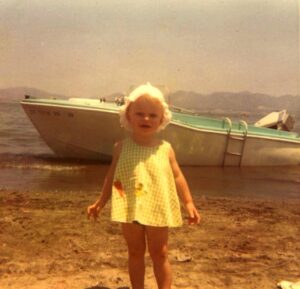
As my body developed, I noticed that my legs and upper arms didn't quite look like those of anyone else in my family. I've always had larger calves, what I used to call "cankles," and my upper arms were also on the larger side. At the age of 10, my mother got me a "water pill" prescription to help with what she observed as water retention. Looking back at old photos and reflecting on my puberty years, it's evident now that Lipedema was present throughout my life. Unfortunately, at that time,
I had no idea what it was, and I’d spent decades feeling bad about how my body looked. From puberty to peri-menopause, I’ve struggled with dieting, coping through food when stressed, feeling ashamed, and often avoiding activities where wearing shorts or tank tops is the norm as I tried to hide from societal beauty standards. (photo Lisa as a young child)
Pregnancy
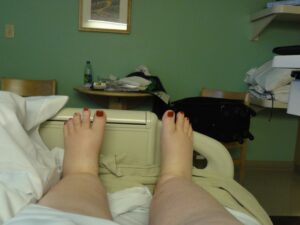
Getting pregnant wasn't easy for me; it involved six years of heartbreak and feelings of shame as I felt that my body, once again, failed to support me. I went through countless infertility treatments, from pills to hormone injections and holistic approaches, all in the hope of conceiving a child.
During my journey toward pregnancy, I faced a significant challenge related to my BMI. The infertility doctor informed me that my BMI was too high for them to work with us, so I embarked on a diligent mission to bring it down to an acceptable range for their IVF program.
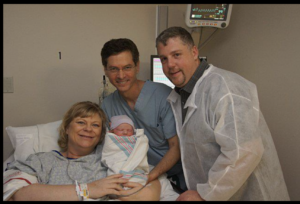
Finally, at 43, I experienced the joy of giving birth to our beautiful daughter, Emily. However, the delivery was not without its complications. Emily was transverse, and I had to undergo a C-section. During this time, my blood pressure skyrocketed, and my legs became extremely swollen. Focused on being a new mother, I brushed aside any concerns about my body and failed to recognize the signs of Lipedema gaining momentum in my body. (photo family with doctor in the hospital)
Peri-menopause

Weight has always occupied a significant space in my mind. The cycle of dieting, feelings of shame, and personal judgment became all too familiar to me. I often wondered why some people could successfully lose and maintain weight through informed food choices. In contrast, for me, whatever weight I managed to shed would inevitably come back, usually with some additional pounds.
Reading numerous articles on the ineffectiveness of fad diets only reinforced the need for a more scientific approach. That's when I decided to join an 82-week medically supervised weight loss program. This program gave me guidance and support to make sustainable changes. I embarked on a journey to shed excess weight, and in 82 weeks, I lost 85 pounds.
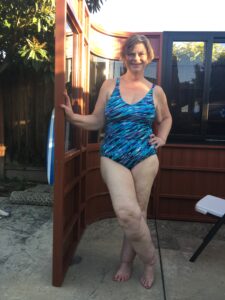
However, despite my success in losing weight, my legs and arms still remained larger than the rest of my body. I noticed lumps on my knees and ankles getting bigger. I had always assumed they were cellulite or fat that would be lost with dieting. I was wrong. It was a frustrating realization that my efforts had not entirely resolved the underlying issues I had with my body.
Menopause
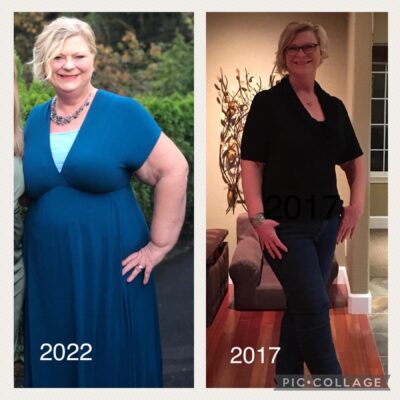 Over time, the lost weight began to creep back up, and I grappled with the same familiar struggles. Yet, it was harder to move, and my legs ad arms were getting bigger, and now my stomach and butt were too. It felt like every four to six months, I had to buy larger bras and underwear, and it was freaking me out. My knees began to hurt when standing in lines, and I started avoiding the stairs.
Over time, the lost weight began to creep back up, and I grappled with the same familiar struggles. Yet, it was harder to move, and my legs ad arms were getting bigger, and now my stomach and butt were too. It felt like every four to six months, I had to buy larger bras and underwear, and it was freaking me out. My knees began to hurt when standing in lines, and I started avoiding the stairs.
When I canceled our family vacation because I knew I couldn't walk or travel for the trip, I was scared.
Learning to Live with Lipedema
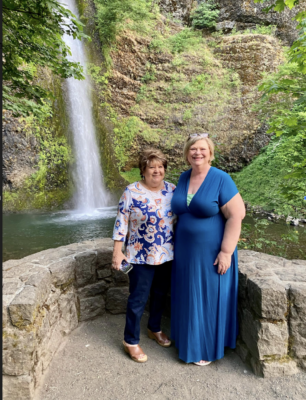
During this period, my stepmom Stella introduced me to Lipedema. She approached the subject delicately and shared an enlightening article with me. Reading about the symptoms and challenges of Lipedema, such as swelling, pain, bruising, and ankle cuffs (what I used to call cankles), felt like looking in a mirror. This discovery prompted me to delve deeper into lipedema research and led me to The Disease They Call Fat Documentary, which empowered me to take action.
I took the initiative to discuss lipedema with my primary care doctor and shared relevant literature. She listened, supported me, and referred me to physical therapy and a functional capacity exam. Based on my symptoms and the information I provided, she diagnosed me and continued to learn alongside me.
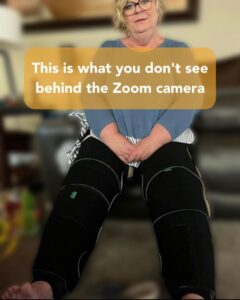 I explored liposuction and focused on conservative care while educating myself about the disease and its effects on my body. In May 2022, I received a formal diagnosis of Stage 3 Lipo Lymphedema after consulting with a lipedema liposuction surgeon. I sought confirmation from another surgeon in July 2022 to ensure accuracy.
I explored liposuction and focused on conservative care while educating myself about the disease and its effects on my body. In May 2022, I received a formal diagnosis of Stage 3 Lipo Lymphedema after consulting with a lipedema liposuction surgeon. I sought confirmation from another surgeon in July 2022 to ensure accuracy.
To document my journey and share information with loved ones, I created a private Facebook group. Sharing the diagnosis with friends was often met with confusion due to their lack of awareness about lipedema. This prompted me to find a way to easily share updates and raise awareness, realizing the power of storytelling and community support.
I found an amazing and kind Manual Lymphatic Drainage (MLD) therapist who understood lymphedema and was eager to learn about lipedema alongside me. Despite driving 45 minutes each way, I visited her office regularly for treatment to stimulate lymphatic drainage.
Experimenting with my diet, I went gluten-free and noticed a reduction in pain as I maintained the new routine. However, this process was demanding on my schedule, finances, and mental well-being. Recognizing my fatigue, I asked for help from family members and embarked on a journey of self-research, becoming more attuned to how my body reacted to food, weather, and stress.
A serendipitous encounter led me to connect with Catherine Seo, the creator of The Disease They Call FAT. Her willingness to chat and help me understand my condition filled me with hope. Through Catherine, I discovered the Lipedema Simplified Community TRIBE, which provided valuable insights, lymphatic and lipedema education, research, and a supportive community of patients, medical experts, and caregivers.
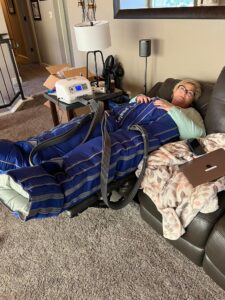 I ordered medical-grade compression garments, although I initially found them difficult to wear and disliked them. Through tips from the TRIBE community and my MLD therapist, I learned how to make them more comfortable and began wearing them daily.
I ordered medical-grade compression garments, although I initially found them difficult to wear and disliked them. Through tips from the TRIBE community and my MLD therapist, I learned how to make them more comfortable and began wearing them daily.
Seeing the impact of lipedema on countless women and the challenges they face, including pain and reduced mobility as the disease progresses, motivated me to use my platform to raise awareness. I incorporated discussions about disability into the ongoing diversity, equity, and inclusion conversations within the organizations I work with.
I obtained insurance coverage for a portion of my Lympha Press pneumatic compression pump, which I now use three times a day for an hour each time. Consistency with the treatment has led to reduced swelling, decreased pain, and improved mobility in my legs.
As I delved deeper into understanding the complexities of this disease and the frequency of misdiagnosis, I began sharing my story publicly as a speaker, on social media, and in appropriate client meetings, reclaiming my voice and raising awareness.
The rest of my journey is still unfolding...
What was once a state of depression and fear has transformed into curiosity and grace. Understanding my condition has provided clarity on how to live well with lipolympedema and has reshaped my perspective on the complexities of weight management and chronic illness. I now recognize the need for increased awareness and accessible healthcare treatments.
Reflecting on my entire journey, I can say that I’ve never felt that I looked normal no matter what I did. The truth is….Lipedema is disfiguring. Now that I understand this disease more I am no longer striving to look normal by society's standards - now I strive for grace and self-love regardless of how my body looks.
Reflections & Moving Forward...

I've come to realize that my lymphatic system received little attention from healthcare professionals throughout my lifetime. Despite my weight loss journey and fertility struggles, the size of my legs and arms and the potential impact on my lymphatic system was never addressed. I see an urgent need for a comprehensive and holistic approach to healthcare that acknowledges the interconnectedness of our bodies and recognizes the importance of the lymphatic system in overall well-being.
Moving forward, I remain committed to raising awareness about the lipedema, the lymphatic system and advocating for its inclusion in healthcare education. By fostering continued education and dialogue, we can bridge the existing gaps, ensure accurate and early diagnoses, provide appropriate treatments, and ultimately improve the overall well-being of all individuals. (photo - drawing by my daughter Emily, "Lipedema Warrior")
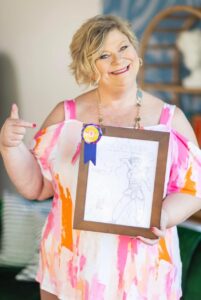
Amazing...


